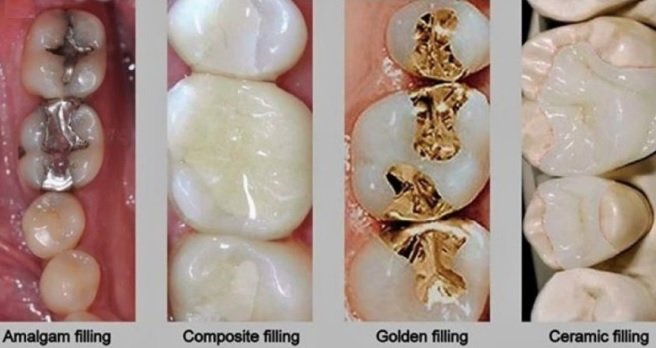
Are Dental Fillings Permanent?
Dental fillings are not permanent. The durability of a filling depends on factors such as the filling material, oral hygiene, biting forces, and individual habits.
While fillings are designed to be durable, they are not intended to last a lifetime.
Durability of Dental Fillings:
Dental fillings are designed to be durable and withstand the daily pressures of chewing and biting. The longevity of a filling largely depends on the material used.
Different filling materials, such as amalgam (metal fillings), composite resin (tooth-colored fillings), GIC (glass ionomer cement) have varying levels of durability.
Amalgam fillings, known for their strength, have traditionally been considered highly durable and long-lasting. They can withstand significant biting forces and are less likely to wear down quickly. However, they are more noticeable due to their metallic appearance. (discontnued – not in use)
Composite resin fillings offer a more aesthetically pleasing alternative, as they can be color-matched to the natural tooth shade. While composite fillings have improved in strength and durability over the years, they may not be as resilient as amalgam fillings, particularly in high-stress areas or for larger restorations.
Glass ionomer cement (GIC) is another type of filling material that has unique properties. GIC is a tooth-colored material that releases fluoride and bonds chemically to the tooth structure. While GIC is not as strong as amalgam or composite resin, it has the advantage of promoting remineralization and reducing the risk of recurrent decay. However, GIC fillings may be more susceptible to wear and fracture compared to other materials.
Why Dental Fillings Do Not Last
- Material Selection: The longevity of a dental filling depends on the type of material used. Different materials, such as amalgam (metal fillings) or composite resin (tooth-colored fillings), have varying durability and wear resistance. Each material has its advantages and disadvantages in terms of longevity.
- Size and Location of the Cavity: The size and location of the cavity being filled can impact the durability of the filling. Large or deep cavities may require more extensive preparation, and the resulting filling may be weaker or more prone to failure.
- Biting Forces and Grinding: Excessive biting forces, such as clenching or grinding of teeth (bruxism), can put stress on the filling, leading to wear, fracture, or dislodgement. The repeated pressure from these habits can gradually weaken the filling over time.
- Marginal Leakage: Marginal leakage occurs when the interface between the filling and the tooth develops gaps or openings. This can happen due to factors like improper placement, inadequate adhesion, or natural wear and tear. Marginal leakage can lead to recurrent decay and ultimately compromise the integrity of the filling.
- Tooth Decay: Fillings may not last if there is ongoing tooth decay around or beneath the filling. If proper oral hygiene is not maintained, bacteria can infiltrate the tooth structure, causing new cavities or weakening the existing filling.
- Age and Wear: Dental fillings, like any dental restoration, can wear out over time due to normal wear and tear. They may degrade or become discolored, making them less effective in sealing and protecting the tooth.
What You Can Do to Help Fillings Last Longer
- Maintain Good Oral Hygiene: Brush your teeth twice a day with a fluoride toothpaste and floss daily. Good oral hygiene helps prevent recurrent decay and promotes the overall health of your teeth and gums.
- Avoid Excessive Force: Be mindful of habits like teeth grinding or clenching. If you have bruxism, consult your dentist, who may recommend a custom-made nightguard to protect your teeth and fillings.
- Regular Dental Check-ups: Visit your dentist regularly for check-ups and professional cleanings. Your dentist can detect any issues with your fillings early on and provide necessary interventions to prevent further damage.
- Reduce Acidic and Sugary Foods: Limit your consumption of acidic foods and beverages, as they can contribute to enamel erosion and weakening of fillings. Additionally, reduce sugary snacks and drinks, as they can increase the risk of tooth decay around the filling.
- Use Mouthguards During Sports: If you participate in contact sports or activities with a risk of dental injury, wear a mouthguard to protect your teeth and fillings from potential damage.
- Follow Dentists’ Recommendations: If your dentist recommends replacement or repair of a filling, it’s important to follow their advice promptly. Ignoring necessary treatment can lead to more extensive dental problems down the line.
Conclusion : Are Fillings Permanent?
In conclusion, dental fillings are designed to be durable and withstand the pressures of chewing and biting.
The longevity of a filling depends on the material used, with amalgam fillings known for their strength and durability, while composite resin fillings offer better aesthetics. Glass ionomer cement (GIC) has unique properties but may be more susceptible to wear.
Regardless of the filling material, proper oral hygiene, regular dental check-ups, and maintenance are key to maximizing the lifespan of fillings and preserving oral health.
Dental Fillings Cost in Gurgaon
Book Appointment for Dental fillings in Gurgaon

Dr. Jyoti Singh (MDS), Diplomate WICO (Japan region) stands as a beacon of excellence in implantology within Delhi NCR region. She is a BDS and MDS(Prostho) both from Maulana Azad Institute of Dental Sciences, where she secured top honors with all India rank 1 in PG entrance examination. Her extensive experience at esteemed institutions like Clove Dental and her own Center for Dental Implants & Esthetics since 2016, Dr. Singh embodies unparalleled expertise in dental implants. Boasting a wealth of 16 years in dentistry and backed by 18 groundbreaking research papers in leading international journals (Google Scholar) and her ResearchGate profile, she epitomizes the pinnacle of proficiency and innovation in her field. She practices in Gurugram as your friendly dentist near me.
